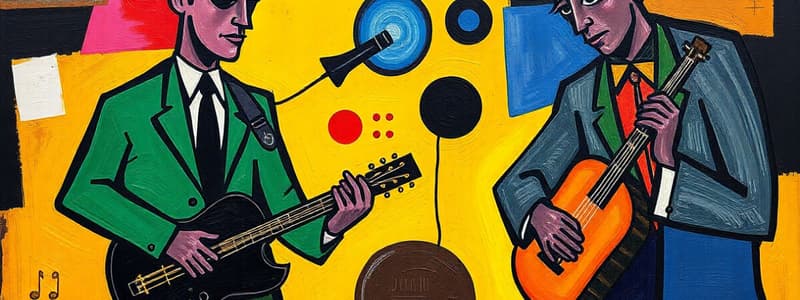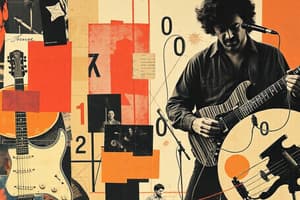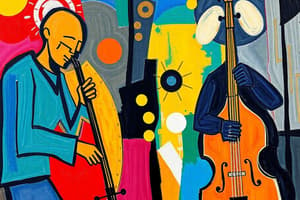Podcast
Questions and Answers
Which musical element is most crucial to jazz, distinguishing it from earlier forms like ragtime?
Which musical element is most crucial to jazz, distinguishing it from earlier forms like ragtime?
- The combination of African syncopations with European formal structures.
- The use of a cyclical harmonic framework. (correct)
- Emphasis on homophonic textures and diatonic melodies.
- Reliance on through-composed, linear structures.
How did the blues influence the development of jazz music?
How did the blues influence the development of jazz music?
- By introducing a cyclical harmonic framework that allowed for continuous improvisation. (correct)
- By providing a structured, fully notated format for compositions.
- By establishing a preference for syncopated rhythms derived from European marches.
- By limiting the harmonic structures to tonic, subdominant, and dominant relationships.
Which statement accurately contrasts the harmonic structures used in ragtime and blues?
Which statement accurately contrasts the harmonic structures used in ragtime and blues?
- Blues primarily uses tonic, subdominant, and dominant relationships, while ragtime explores multiple keys. (correct)
- Ragtime incorporates improvisation over a recurring harmonic framework, unlike the fixed harmonic structures of blues.
- Blues is strictly diatonic, while ragtime utilizes pentatonic scales for melodic improvisation.
- Ragtime relies on a cyclical I-IV-V harmony, while blues uses linear chord progressions.
What is one key distinction between country blues and urban blues styles?
What is one key distinction between country blues and urban blues styles?
Which musical element is characteristic of ragtime music?
Which musical element is characteristic of ragtime music?
Which of the following describes the form of a typical ragtime composition, such as Scott Joplin’s 'Maple Leaf Rag'?
Which of the following describes the form of a typical ragtime composition, such as Scott Joplin’s 'Maple Leaf Rag'?
How did Scott Joplin attempt to elevate the artistic perception of ragtime music?
How did Scott Joplin attempt to elevate the artistic perception of ragtime music?
Elmore James, an urban blues guitarist, significantly influenced later rock artists through his...
Elmore James, an urban blues guitarist, significantly influenced later rock artists through his...
Which aspect of Blind Lemon Jefferson's music is most reflective of his rural background?
Which aspect of Blind Lemon Jefferson's music is most reflective of his rural background?
What distinguishes the texture of blues and ragtime music?
What distinguishes the texture of blues and ragtime music?
What is the role of 'call and response' in blues music?
What is the role of 'call and response' in blues music?
What is a key difference between blues and ragtime in terms of improvisation?
What is a key difference between blues and ragtime in terms of improvisation?
Which of the following composers was NOT directly influenced by the ragtime idiom?
Which of the following composers was NOT directly influenced by the ragtime idiom?
How does the rhythmic feel of ragtime differ from that of traditional European marches?
How does the rhythmic feel of ragtime differ from that of traditional European marches?
How did the Atlantic slave trade affect music?
How did the Atlantic slave trade affect music?
Flashcards
Blues and Ragtime
Blues and Ragtime
Musical forms created by African-Americans through the merging of African and European cultural traditions.
The Blues
The Blues
Evolved from field hollers, spirituals, and Christian hymns and focuses on improvisation.
Frank Tirro's Definition of Blues
Frank Tirro's Definition of Blues
The music of people, a style of music, a type of performance, a despondent state of mind and a musical form. All these things, the blues has contributed to jazz.
Improvisation
Improvisation
Signup and view all the flashcards
Ragtime
Ragtime
Signup and view all the flashcards
Blind Lemon Jefferson
Blind Lemon Jefferson
Signup and view all the flashcards
Elmore James
Elmore James
Signup and view all the flashcards
Scott Joplin
Scott Joplin
Signup and view all the flashcards
Cyclical Framework
Cyclical Framework
Signup and view all the flashcards
Timbre
Timbre
Signup and view all the flashcards
Homophonic Texture
Homophonic Texture
Signup and view all the flashcards
Call and Response
Call and Response
Signup and view all the flashcards
Ragtime Form
Ragtime Form
Signup and view all the flashcards
Pentatonic Scale
Pentatonic Scale
Signup and view all the flashcards
12-Bar Blues
12-Bar Blues
Signup and view all the flashcards
Study Notes
- The Atlantic slave trade brought West Africans to the United States against their will.
- African and European cultural traditions clashed, leading to new musical forms by African-Americans.
- These forms merged into blues and ragtime.
Blues
- Blues is central to jazz and evolved from field hollers, spirituals, and Christian hymns.
- Categories of blues include country blues, urban blues, instrumental blues, and classic blues.
- The blues influenced country, gospel, rock, and popular music.
- Frank Tirro describes the blues as music of people, a style, a performance type, a state of mind, and a musical form.
- Continuous improvisation over a recurring harmonic framework is important to jazz.
- Improvisation is a key characteristic of jazz.
- The harmonic and rhythmic framework is the form of the music.
Ragtime
- Ragtime is a syncopated European style of piano music with a formal structure from polkas and marches.
- The polka/march structure was combined with African syncopations.
- Solo piano is the main instrument, but brass bands, solo banjo, and vocal with accompaniment were also utilized.
- Ragtime is through-composed (linear) music, with no improvisation.
- Ragtime influenced classical composers like Debussy, Satie, and Stravinsky.
Blind Lemon Jefferson (1897 – 1930)
- Born in Texas to a farming family and blind from birth.
- His music is an example of country blues.
- His music reflected work songs, religious pieces, and rural Afro-American life.
- He moved to Chicago and recorded extensively.
Elmore James (1918 – 1963)
- Born in Mississippi and died in Chicago.
- He was influenced by Robert Johnson.
- He was an urban blues guitarist noted for his use of the slide guitar.
- He inspired artists including The Rolling Stones, Jimi Hendrix, and ZZ Top.
Scott Joplin (1868 – 1917)
- Born in Texas, the son of a former slave.
- He was a classically trained pianist and composer.
- He lived in St Louis, Chicago, and New York.
- Joplin dedicated his life to raising the artistic profile of ragtime.
- He fused ragtime with classical ballet and opera.
- Lack of public response to his fusion contributed to his ill health and death in a mental hospital.
Blind Lemon Jefferson – Lonesome House Blues
- Style: Blues
- The melody and improvisations are from the pentatonic/blues scale.
- The piece makes use of ‘call and response’.
- The form is cyclical and 12 bars in length.
- The harmony is I, IV, V with a 12/8 rhythm.
- The instrumentation (solo guitar/vocals) is typical of rural/country blues.
- Country blues has a rougher vocal timbre.
- Blues is generally homophonic in texture.
Elmore James – Dust my Broom
- Style: Blues
- The melody and improvisations are from the pentatonic/blues scale.
- The piece makes use of ‘call and response’.
- The form is cyclical and 12 bars in length.
- The harmony is I, IV, V with a 12/8 rhythm.
- The instrumentation (guitar/vocals with piano, bass, drums) is typical of urban blues.
- Urban blues uses a strict tempo.
- Blues is generally homophonic in texture.
Scott Joplin – Maple Leaf Rag
- Style: Ragtime
- The melody consists of contrasting themes which are diatonically derived.
- There is no improvisation.
- The form is linear: AABBACCDD.
- The harmony uses tonic (I), subdominant (IV), and dominant (V) relationships.
- It has a two beat pulse (2/4 ‘oompah’ feel).
- The syncopated melody line has "ragged time".
- The instrumentation is solo piano.
- Ragtime is generally homophonic in texture.
Studying That Suits You
Use AI to generate personalized quizzes and flashcards to suit your learning preferences.




